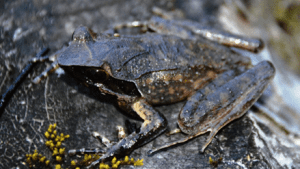TAG: GS 3: ECOLOGY AND ENVIRONMENT
THE CONTEXT: A groundbreaking discovery has emerged from the forests of Arunachal Pradesh, where a team of researchers from the Zoological Survey of India (ZSI) has identified a new species of horned frog.
EXPLANATION:
- This species, named Xenophrys apatani, was found in the Talle Wildlife Sanctuary located in the Lower Subansiri district.
- The discovery was led from ZSI Shillong. Their collaborative efforts resulted in the identification and classification of the new species.
Xenophrys apatani
- The species has been named Xenophrys apatani in honor of the Apatani community, which is prominent in the region.
- This naming serves as recognition of the community’s dedication to the conservation of wild flora and fauna in their area.
- The identification of Xenophrys apatani adds a valuable entry to India’s herpetofaunal diversity, reflecting the rich and varied biodiversity of the region.
- This discovery is particularly notable in the context of the Eastern Himalayan and Indo-Burma biodiversity hotspots.
- The researchers also provided valuable insights into the biogeographic distribution of Xenophrys species within India.
- Their findings contribute to a better understanding of amphibian evolution and distribution in these ecologically significant regions.

Significance of the Discovery
- This new identification corrects a previous error made in 2019, where researchers from ZSI Shillong misidentified the species as the Maoson horned frog (Xenophrys maosonensis).
- Subsequent analysis revealed significant genetic differences between the Indian specimens and those from Vietnam and China, leading to the re-evaluation and correct identification as a new species.
- The revised conclusion was based on thorough genetic analysis, highlighting substantial disparities that prompted this significant update.
- This discovery underscores the necessity of rigorous taxonomic studies to fully understand and appreciate the rich biodiversity present in India.
Future Conservation Efforts
- The findings from this study are expected to inform and guide future conservation efforts.
- Understanding the distribution and genetic diversity of species like Xenophrys apatani is crucial for developing effective strategies to protect these unique amphibians and their habitats.

